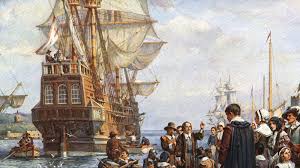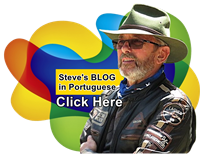Instruções:
Essas aulas de inglês são para alunos intermediários e avançados de inglês como segunda língua. Eles incluem “Ler”, “Ouvir” e “Escrever”. Basta seguir a lição respondendo às perguntas à medida que as encontra. Todas as vagas em negrito devem ser traduzidas para seu próprio idioma para ajudar na compreensão do novo vocabulário.
Mayflower was an English ship that transported a group of English families, known today as the Pilgrim Fathers, from England to the New World (America) in 1620. This is the story of the origins of “Thanks Giving”
After the previous lesson on the history of Levi Strauss and the gold rush in the United States I was asked to do a similar lesson on the history of the Mayflower ship and how “Thanks Giving” came about. Here is that story.
Section 1 (Introduction)
This is the story of the connection between what we know as the holiday “Thanks Giving” that happens each year in the United States and The Pilgrim Fathers aboard the British ship “The Mayflower.” 
The Mayflower set sail on 16th September 1620 from Plymouth, UK, to voyage to America. But its history and story start long before that.
Its passengers were in search of a new life – some seeking religious freedom, others a fresh start in a different land. They would go on to be known as the Pilgrims and influence the future of the United States of America in ways they could never have imagined.
Section 2
VIDEO LEARNING: Listen to and watch the video below about the history of “Thanks Giving” then answer the questions below.
Questions to answer whilst listening to the video:
- When was Columbus’s voyage?
- What were people looking for when they travelled to the Americas?
- What does the verb to “leak” mean?
- How many times did the Mayflower attempt to sail?
- What animals did they take with them?
- What does “to rock and tilt in the waves” mean?
- When was land sighted?
- Where did they anchor?
- What did they name the first settlement after they landed?
- Who helped the settlers to survive in nthe new land?
Section 3
This story isn’t just about the Mayflower’s passengers though. It’s about the people who already lived in America and the enormous effect the arrival of these colonists would have on Native Americans and the land they had called home for centuries.
More than 30 million people can trace their ancestry to the 102 passengers and approximately 30 crew aboard the Mayflower when it landed in Plymouth Bay, Massachusetts, in the harsh winter of 1620. 
On board were men, women and children from different walks of life across England and the city of Leiden in Holland.
A significant number were known as Separatists, a group of people who mostly wanted to live a life free from the current Church of England.
Others were on the ship for a multitude of reasons – some anticipated the chance to build a better future for their families and the opportunity of new land, while for others the offer of freedom and adventure was too good to turn down.
Section 4
Then there were the crew themselves, plus the servants and unaccompanied children sent by their families to be looked after by the adults.
The passengers are often grouped into ‘Saints’ or ‘Strangers’ by historians, alluding to their motivations for the journey. But it’s likely that many ‘Saints’ were skilled tradesmen and many ‘Strangers’ had their own religious reasons for leaving 17th century England.
The origins of these passengers can be traced across England and in the Netherlands – as illustrated by the interactive map below.
Importantly, the Pilgrims were not the first to land in America, nor did they discover it. There were already established colonies at the time, not least Jamestown – founded in 1607. 
But the Mayflower story is renowned for its themes of freedom and humanity – including the relationships first formed between the Native American Wampanoag tribe and the colonists and the first Thanksgiving.
We begin much earlier than 1620, in the villages, towns and cities of England.
Section 5
The King of England
The decision by Henry VIII to break away from the Roman Catholic Church – principally so he could divorce his first wife, Catherine of Aragon, had far-reaching ramifications. 
He created his own church, with its own rules determined by him – called the Church of England. In doing this, Henry was expelled by the Pope and the reformation of the English churches had started.
Many believed that Henry’s new church was still too similar to the Pope’s and wanted even more changes. Some wanted to separate it from other churches by purifying it of all Catholic practices. They became known as the Puritans.
However, others believed that you could not change the church and that the only way to form a new group was to break away entirely. They became known as the Separatists.
The Church dictated all aspects of life – from what you ate to what you wore. To dispute that rule was a dangerous path ending in prosecution. This was especially foreboding for Separatists.
Section 6
The Separatist leaders
The leading religious Separatists who voyaged to America in 1620 mostly originated from an area where modern-day Nottinghamshire, Yorkshire and Lincolnshire meet. Regarded as dangerous renegades who rejected fundamental principles of the State and the established Church of England, they worshipped in secret to avoid arrest and persecution. 
Among them was William Brewster, who was brought up in the village of Scrooby in north Nottinghamshire.
Inspired by the radical words of Richard Clifton, the rector of nearby All Saints’ Church in Babworth, Brewster is believed to have founded a Separatist Church in his family home – the manor house at Scrooby.
Section 7
Thanks Giving
Thanksgiving Day is a national holiday in the United States, and Thanksgiving 2022 occurs on Thursday, November 24. In 1621, the Plymouth colonists and the Wampanoag shared an autumn harvest feast that is acknowledged today as one of the first Thanksgiving celebrations in the colonies. For more than two centuries, days of thanksgiving were celebrated by individual colonies and states. It wasn’t until 1863, in the midst of the Civil War, that President Abraham Lincoln proclaimed a national Thanksgiving Day to be held each November.
Thanksgiving at Plymouth
In September 1620, a small ship called the Mayflower left Plymouth, England, carrying 102 passengers—an assortment of religious separatists seeking a new home where they could freely practice their faith and other individuals lured by the promise of prosperity and land ownership in the “New World.” After a treacherous and uncomfortable crossing that lasted 66 days, they dropped anchor near the tip of Cape Cod, far north of their intended destination at the mouth of the Hudson River. One month later, the Mayflower crossed Massachusetts Bay, where the Pilgrims, as they are now commonly known, began the work of establishing a village at Plymouth.
Throughout that first brutal winter, most of the colonists remained on board the ship, where they suffered from exposure, scurvy and outbreaks of contagious disease. Only half of the Mayflower’s original passengers and crew lived to see their first New England spring. In March, the remaining settlers moved ashore, where they received an astonishing visit from a member of the Abenaki tribe who greeted them in English. Several days later, he returned with another Native American, Squanto, a member of the Pawtuxet tribe who had been kidnapped by an English sea captain and sold into slavery before escaping to London and returning to his homeland on an exploratory expedition. Squanto taught the Pilgrims, weakened by malnutrition and illness, how to cultivate corn, extract sap from maple trees, catch fish in the rivers and avoid poisonous plants. He also helped the settlers forge an alliance with the Wampanoag, a local tribe, which would endure for more than 50 years and tragically remains one of the sole examples of harmony between European colonists and Native Americans.
Section 8
In November 1621, after the Pilgrims’ first corn harvest proved successful, Governor William Bradford organized a celebratory feast and invited a group of the fledgling colony’s Native American allies, including the Wampanoag chief Massasoit. Now remembered as American’s “first Thanksgiving”—although the Pilgrims themselves may not have used the term at the time—the festival lasted for three days. While no record exists of the first Thanksgiving’s exact menu, much of what we know about what happened at the first Thanksgiving comes from Pilgrim chronicler Edward Winslow, who wrote:
“Our harvest being gotten in, our governor sent four men on fowling, that so we might after a special manner rejoice together, after we had gathered the fruits of our labors; they four in one day killed as much fowl, as with a little help beside, served the Company almost a week, at which time amongst other Recreations, we exercised our Arms, many of the Indians coming amongst us, and amongst the rest their greatest king Massasoit, with some ninety men, whom for three days we entertained and feasted, and they went out and killed five Deer, which they brought to the Plantation and bestowed on our Governor, and upon the Captain and others. And although it be not always so plentiful, as it was at this time with us, yet by the goodness of God, we are so far from want, that we often wish you partakers of our plenty.”
Historians have suggested that many of the dishes were likely prepared using traditional Native American spices and cooking methods. Because the Pilgrims had no oven and the Mayflower’s sugar supply had dwindled by the fall of 1621, the meal did not feature pies, cakes or other desserts, which have become a hallmark of contemporary celebrations
Section 9
Pilgrims held their second Thanksgiving celebration in 1623 to mark the end of a long drought that had threatened the year’s harvest and prompted Governor Bradford to call for a religious fast. Days of fasting and thanksgiving on an annual or occasional basis became common practice in other New England settlements as well. During the American Revolution, the Continental Congress designated one or more days of thanksgiving a year, and in 1789 George Washington issued the first Thanksgiving proclamation by the national government of the United States; in it, he called upon Americans to express their gratitude for the happy conclusion to the country’s war of independence and the successful ratification of the U.S. Constitution.  His successors John Adams and James Madison also designated days of thanks during their presidencies.In 1817, New York became the first of several states to officially adopt an annual Thanksgiving holiday; each celebrated it on a different day, however, and the American South remained largely unfamiliar with the tradition.
His successors John Adams and James Madison also designated days of thanks during their presidencies.In 1817, New York became the first of several states to officially adopt an annual Thanksgiving holiday; each celebrated it on a different day, however, and the American South remained largely unfamiliar with the tradition.
In 1827, the noted magazine editor and prolific writer Sarah Josepha Hale—author, among countless other things, of the nursery rhyme “Mary Had a Little Lamb”—launched a campaign to establish Thanksgiving as a national holiday. For 36 years, she published numerous editorials and sent scores of letters to governors, senators, presidents and other politicians, earning her the nickname the “Mother of Thanksgiving.”Abraham Lincoln finally heeded her request in 1863, at the height of the Civil War, in a proclamation entreating all Americans to ask God to “commend to his tender care all those who have become widows, orphans, mourners or sufferers in the lamentable civil strife” and to “heal the wounds of the nation.” He scheduled Thanksgiving for the final Thursday in November, and it was celebrated on that day every year until 1939, when Franklin D. Roosevelt moved the holiday up a week in an attempt to spur retail sales during the Great Depression. Roosevelt’s plan, known derisively as Franksgiving, was met with passionate opposition, and in 1941 the president reluctantly signed a bill making Thanksgiving the fourth Thursday in November.
[rafflepress id=”1″]
Question: Was the historical discovery of your country different from or similar to the historical discovery of The United States. In what way.
Writing: (Write 150 words explaining to me how, when and by who Brazil was discovered) It should be a “POTTED HISTORY” of the discovery of Brazil.
Grammar to use: In your essay please include two examples of the past perfect and past perfect progressive.
Write your essay here CLICK HERE using this link and send it to me for marking.
Below are some Amazon ebooks to download and help you study. Simply click the book cover to download.







